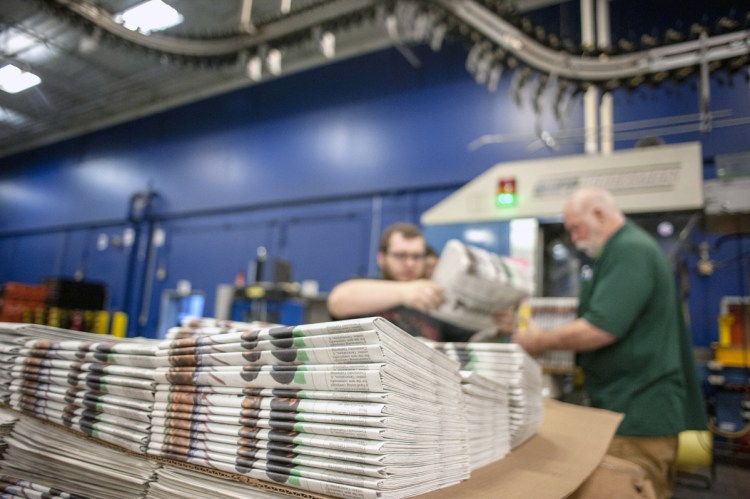MILWAUKEE — Newspaper publishers across the U.S. already strapped by years of declining revenue say they’re dealing with an existential threat: Recently imposed tariffs on Canadian newsprint driving up their business costs.
The tariffs are a response to a complaint to the U.S. Department of Commerce from a hedge fund-owned paper producer in Washington state, which argues that its Canadian competitors are taking advantage of government subsidies to sell their product at unfairly low prices. The tariffs, imposed in January and increased in March, are not permanent yet. But newspaper publishers are bracing for another blow to an industry that has shrunk with the loss of advertising revenue to the internet.
Critics of the paper tariffs say the businesses that will ultimately be harmed are not Canadian paper producers, but U.S. newspapers that will have to cut staff and reduce publication days to afford higher prices of newsprint – the sheets newspapers are printed on. The newspaper industry employs just over 150,000 Americans, which is about 276,000, or 65 percent, fewer than two decades ago.
“To get an unbudgeted increase of this magnitude will be for many publishers very, very serious to catastrophic,” said Tom Slaughter, the executive director of the Inland Press Association, which represents about 1,500 daily and non-daily newspapers in every state.
A large metro newspaper can expect annual increases of about $3 million in printing costs, according to Paul Boyle, senior vice president for the News Media Alliance. While larger papers might be able to survive the increase, Boyle said smaller publications might not.
“I’ve heard from small publishers who’ve said, ‘I’m worried about shutting my doors,”‘ he said.
Boyle said his organization – formerly called the Newspaper Association of America – is compiling a survey from its members and nearly every publisher is exploring layoffs and scaling back news coverage.
Steve Stewart, publisher of The State Journal in Frankfort, Kentucky, told readers in a March 30 column that the newspaper they were reading cost 10 percent more to produce than a few weeks earlier and could cost as much as 40 percent more in a few months. He said this will result in fewer pages, higher subscription costs and less non-local content.
The newsprint tariffs reflect President Trump’s tough new approach to U.S. trade relations. Trump is engaged in a tense standoff with China over Beijing’s sharp-elbowed attempts to gain access to U.S. technology. He’s trying to renegotiate the North American Free Trade Agreement with Mexico and Canada. And his administration has wrangled with Canada directly over low-priced Canadian timber imports, Canadian barriers to U.S. dairy farmers, and now cheap Canadian newsprint.
The International Trade Commission is expected to make a final determination on the tariffs in August or September.
Canadian newsprint producers began paying an average of 6.53 percent more to export their products to the U.S. in January, when the Commerce Department concluded that would help offset the foreign paper mills’ advantage over American companies. In March, the department increased the cost by another 22 percent after its preliminary investigation concluded that one Canadian company, British Columbia-based Catalyst, was underselling the uncoated groundwood paper newspapers use by that much less.
In response to the second increase, Catalyst said the tariff was “without merit” and that it “will continue to vigorously defend itself against an unwarranted and onerous U.S. trade action.”
The North Pacific Paper Company, which New York hedge fund One Rock Capital Partners bought in 2016, petitioned for the tariffs, arguing that Canadian companies had an unfair advantage. NORPAC, which employs about 300 people, is the only U.S. paper producer making that argument.
The U.S. currently has five operating mills, including NORPAC. Three are in Washington state, with one of them partly owned by a Canadian company. Canada owns the remaining two in Georgia and Mississippi.
Publishers say Canadian imports are not the reason for the decline of U.S.-based paper mills, but rather a 75 percent drop in newsprint consumption over the last two decades.
Send questions/comments to the editors.



Success. Please wait for the page to reload. If the page does not reload within 5 seconds, please refresh the page.
Enter your email and password to access comments.
Hi, to comment on stories you must . This profile is in addition to your subscription and website login.
Already have a commenting profile? .
Invalid username/password.
Please check your email to confirm and complete your registration.
Only subscribers are eligible to post comments. Please subscribe or login first for digital access. Here’s why.
Use the form below to reset your password. When you've submitted your account email, we will send an email with a reset code.